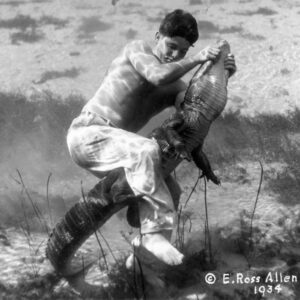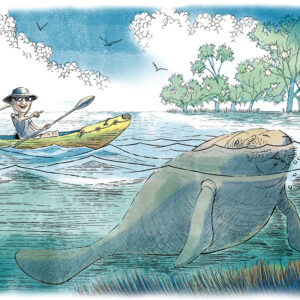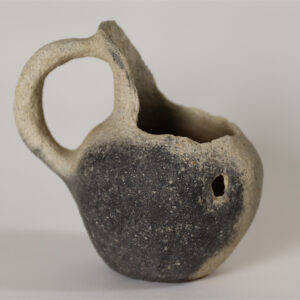

Johnnie Mae Florence had a choice.
And, unbelievably, a choice that a 12-year-old black girl wouldn’t have had a little more than a decade earlier.
It was 1967, and school desegregation, which had been mandated by the U.S. Supreme Court in 1955, was finally gaining some traction. Johnnie Mae, who had attended Ocala’s all-black Dr. N.H. Jones Elementary from first through sixth grade, now had a choice when it came to junior high schools. She could go on to all-black Howard High School, or she could go to predominantly white Osceola Jr. High.
 Far beyond Ocala, as desegregation was changing the country’s culture, there was discord between whites and blacks. Race riots scarred Detroit, Cleveland and Los Angeles. It was an unsettling, frightening time throughout the country.
Far beyond Ocala, as desegregation was changing the country’s culture, there was discord between whites and blacks. Race riots scarred Detroit, Cleveland and Los Angeles. It was an unsettling, frightening time throughout the country.
The middle child of three siblings, Johnnie Mae’s older brother Curtis and younger sister Linda decided to attend Howard High School. When the Supreme Court issued a second and stronger school desegregation ruling in 1969, Howard High School was closed. After the closing, black students went first to Ocala High and then to the new Forest High and Vanguard High.
But little Johnnie Mae, who had never been much of a follower, wasn’t going to wait for the Supreme Court to tell her what to do. Bold even then, she knew that she had a choice—a chance for an equal education—and she grabbed it with both hands.
“I was never afraid. I wanted to go to Osceola Jr. High because I wanted to be part of what was changing in the world,” says Johnnie Mae, 56, now an award-winning, New York-based actress. “I was only a child, but I wanted to be a trailblazer. I decided I wanted to make a difference everywhere I went.”
And in the ensuing four-plus decades since making that choice, Johnnie Mae has indeed blazed a trail from the sidewalks of Ocala to a recurring role in the 2010 season of HBO drama Boardwalk Empire. In between, she relished being the self-described “token black” in everything from talent shows and drama classes to beauty pageants and cheerleading—even in planning to try out for the University of Florida football team. When Johnnie Mae moved to New York City to pursue an acting career in the late 1970s, she parlayed her unique black beauty into work in print ads, commercials, and television and film roles. Gifted with infectious joy and a cheerful laugh, Johnnie Mae even became a comedienne.
“I guess you could say that I’ve always believed in being all I could be,” says Johnnie Mae with her signature laugh that not only fills up a room but spills out into the hallway. “Being a performer is how I connect with people, and it’s who I am.”
Given her desegregation background, the irony of playing Luanne Pratt, the black maid to a rich white man during the Prohibition era in Boardwalk Empire, is not lost on Johnnie Mae. But she never viewed it as going backward, instead as only part of being a performer.

Johnnie Mae on the set of Boardwalk Empire with actor Steve Buscemi
“I’m an actress, a black actress,” says Johnnie Mae matter-of-factly. “The part was for a black maid, so I was definitely right for the part on that basis.” She pauses to laugh, then adds, “So I just set about to be the best black maid I could be.”
Drama made an earlyappearance in Johnnie Mae’s life. Born and raised in western Ocala, Johnnie Mae was only 5 when her parents drowned while fishing on Lake Weir.
“The story we were told is that the wind blew my mother’s hat into the water,” says Johnnie Mae, “and when she reached for it, she fell from the boat into the water. Then, my father jumped in to help her, and they both drowned.”
Johnnie Mae, Curtis and Linda were then raised by maternal grandparents J.Z. and Emma Sims, who had five kids of their own. But to Johnnie Mae and her siblings, J.Z. and Emma became Mama and Daddy. The family attended St. Paul A.M.E. Church, and it was there that Johnnie Mae found her first mentor.
“Mary V. Jones was in charge of the young people in the church,” recalls Johnnie Mae. “She was the one who taught me about public speaking and how to recite poems. Later, Mama bought us a piano, but Curtis is the one who learned to play it. He played, and my sister Linda and I did the singing.”

Johnnie with actor Dabney Coleman
Having made that all-important choice, Johnnie Mae wasted little time in making her presence known at Osceola Jr. High. And it had more to do with her spirit than the color of her skin. Taking note of the newcomer was Jo Anne McClellan, a white student who was a year older than Johnnie Mae but who perhaps sensed the youngster’s destiny early on.
“This was a difficult time for many people,” remembers Jo Anne, whose last name is now Chirdon. “My family had a black maid, and I had friends who had black maids and black yardmen. Now, their children were coming to school with us. I was fine with it, but I often thought how difficult it had to be for the black kids.”
Except for Johnnie Mae, who Jo Anne describes as “this little bright light from the first day.”
“She was on stage from the moment she hit Osceola Jr. High,” says Jo Anne, who went on to Forest High School, as did Johnnie Mae. “I remember that she entered a talent contest and did a lip-sync of the song The Hunter Gets Captured by the Game by the Marvellettes. What courage that little girl had! I always thought she’d accomplish much in her life.”
So when Jo Anne recognized Johnnie Mae while watching Boardwalk Empire last fall, she wasn’t all that surprised.
“I just always thought Johnnie Mae would pursue her acting dreams,” says Jo Anne, “and I was delighted to see that she had!”
Flip through the 1971 Forest High School yearbook, appropriately enough named “Profiles of Courage,” and there’s Johnnie Mae, the one with the biggest smile in all the pictures. She was a member of the Spanish Club, treasurer of the Service (“S”) Club, parliamentarian of the Masque and Wig Club and a varsity cheerleader.
“I didn’t make it the first time I tried out for cheerleader as a sophomore,” says Johnnie Mae, “because I was too black. My best friend, Tara Johnson, was also black and she made the squad. But she was lighter skinned than I was and had beautiful long hair. I was happy for Tara but determined to be a cheerleader.”

Johnnie with actor Michael Kenneth Williams
That summer, Johnnie Mae attended a cheerleading camp as the only participant who wasn’t part of a school squad. By the end of camp, Johnnie Mae had charmed everyone enough to be named Miss Congeniality. And, of course, that fall, Johnnie Mae made the Forest High School cheerleading squad.
As a member of the Masque and Wig Club, Johnnie Mae had a role in nearly every play the drama group staged. She remembers Mrs. Clemmons, the drama teacher, being the first one to mention that she should pursue a show-business career.
“Mrs. Clemmons told me that I needed to go to New York City,” says Johnnie Mae. “And she was the one who told me that when I did that I should just use my first name because it was unusual and people would remember me.”
As it turned out, of course, Mrs. Clemmons was indeed a bit of a clairvoyant. But Johnnie Mae’s New York dream would have to wait. An honor-roll student, Johnnie Mae had the opportunity to go on to college, another choice she rightly made. Having married Paul Richard, a man four years her senior, Johnnie Mae followed him to Tallahassee. He went to Florida A&M while she attended Florida State. A year later, with the marriage shaky, Johnnie Mae transferred to the University of Florida to pursue a degree in broadcast journalism and theater.
Not long afterJohnnie Mae arrived in Gainesville, she was soon smack in the middle of some more drama. It was as though she carried a portable stage with her, rolled up like a yoga mat and tucked under her arm, at the ready whenever she needed to unfurl it.
“The first thing that caught my attention was that black students were not a part of UF Homecoming’s Gator Growl,” says Johnnie Mae. “We put a group together, went to the university’s president and got that changed.”
Then Johnnie Mae, who’d been a Miss UF beauty pageant contestant, had the idea to try out as a wide receiver for the UF football team. This was 1975, and even with Title IX stating that colleges must provide women separate but equal athletic opportunities, Johnnie Mae’s notion was generally considered a crazy one. First, the local media picked up the story, and then it went national, which was just what Johnnie Mae wanted.
“I was going to be graduating in a year, and I was looking for a big break in broadcast journalism,” she says. “I was serious about trying out for the team. I even started working out with some of the players. But what I really wanted was to create myself some name recognition.”
But all the media coverage drawing attention to Johnnie Mae infuriated UF Coach Doug Dickey. He would use Title IX guidelines pertaining to contact sports that allowed for separate men and women teams to deny Johnnie Mae’s tryout request. Later Coach Dickey would make a compromise that pleased Johnnie Mae.
“Coach Dickey was going to let me be on the sidelines for the UF-Miami game,” recalls Johnnie Mae. “I was on my way to being the first woman, the first black woman, sideline color commentator for a college football game.”
The night before the game, already in south Florida, Johnnie Mae received word that her husband Paul had killed himself in a shooting accident. Her broadcasting career dreams died that night, too.
After graduating from UF in 1976, Johnnie Mae decided to take Mrs. Clemmons’ advice and moved to New York City. But the little girl who hadn’t been afraid of desegregation ran into something in New York that did scare her.
“The snow scared me,” admits Johnnie Mae, laughing. “I packed up and came back to warm Ocala.”
Johnnie Mae did social work for two years, but her show-business dreams wouldn’t die. She decided to give New York, snow and all, another try. That was in 1978, and Johnnie Mae has been in New York ever since. She honed her talent, attending the Lee Strasberg Institute, American Community Theatre and Weist-Barron School, and soon, it all began to pay off.
“I started making the rounds of all the acting and modeling agencies,” she says. “And to draw attention to myself, I entered the Miss Black New York beauty pageant. I ended up first runner-up and, after that, started getting showroom modeling work and print ads. My first big TV commercial was for Cold Power laundry detergent in 1980.”
After joining the Screen Actors Guild in 1981, Johnnie Mae’s performing résumé continued to grow impressively. She landed roles in TV shows such as all three incarnations of Law & Order, Oz and 30 Rock. Her theater work has included roles in What Would Jesus Do?, Romeo & Juliet, Native Son, Shakin’ the Mess Outta Misery and Why Old Ladies Cry at Weddings. Johnnie Mae won an AUDELCO Award as best supporting actress for her role as Delores in What Would Jesus Do? And for Shakin’ the Mess Outta Misery, she shared the OOBR Award for best ensemble cast.
“I love all the performing arts,” says Johnnie Mae. “But I really love the theater and performing before an audience. The actress who had the biggest impact on me was Claudia McNeil in A Raisin in the Sun. I hope to have a part in that play soon.”
When Johnnie Mae’s agent Renee Glicker called her about the role of a black maid in an upcoming HBO production, she was happy for the opportunity. She went to the audition dressed in a simple white blouse with a scarf wrapped around her head, emoting in her best Southern black dialect. After reading dialogue for casting director Ellen Lewis, Johnnie Mae went home happy with her performance. As it turned out, she had every reason to be pleased with her effort.
When Lewis met with Terrence Winter, the Emmy Award-winning creator, writer and executive producer of Boardwalk Empire, she let him know she thought they had their actress for the Luanne Pratt role.
“Ellen came to me with three auditions,” says Winter, who along with his many other film credits was also the executive producer and writer of the highly successful The Sopranos. “But she said there really was only one to look at, and when I saw Johnnie Mae’s audition, I knew she was right. We had our Luanne Pratt.”
Winter points out that “on the surface, Luanne Pratt looks like just a simple beleaguered black maid. But there was actually a lot going on beneath the surface with her, and we needed an actress who could convey that. Johnnie Mae had the talent to pull that off.”
Set during the Prohibition era, Winter adapted the show from a chapter about criminal kingpin Enoch “Nucky” Johnson in Nelson Johnson’s book Boardwalk Empire: The Birth, High Times, and Corruption of Atlantic City. The series, which stars Steve Buscemi as the main character, was filmed on a specially created set in Brooklyn made to look like Atlantic City. The pilot, which was directed by Martin Scorsese, premiered on HBO on September 19, 2010, drawing high ratings and critical praise. HBO quickly ordered a full season. Then, after numerous Writers Guild of America and Screen Actors Guild awards for that initial season, HBO is bringing the series back for the 2011 fall season.
“I was so excited to get the part of Luanne,” says Johnnie Mae, adding with a laugh, “In fact, I got too excited and my high blood pressure got out of hand. I had to go to my doctor to adjust my medication, but it was worth it.”
Johnnie Mae’s Luanne character, who was initially only going to be in the pilot, ended up being written into six episodes. She was the maid to Dabney Coleman’s Commodore character, who was very demeaning and mistreated her. Luanne seeks revenge in her own way, using arsenic to poison the Commodore. But the Commodore survives, and Luanne is discovered to be the culprit.
“In my final scene, Nucky gives me money, tells me to go far away, change my name and not to come back,” says Johnnie Mae. “Then, I give him a book with a page marked in it and leave. So there’s some mystery there about that book and what the marked page means.”
Winter isn’t sure if the Luanne character will return but left the door open.
“I like to think of my projects as epic novels where characters come and go,” says Winter. “Johnnie Mae is a very talented actress, and she was a delight to work with. We work long days and nights, but no matter what the hour, she was so joyful and upbeat.”
For Johnnie Mae, the part of Luanne was a gift. She knows that she’s reached a time in her career where most of the roles offered to her will be the women-of-a-certain-age kind. And that’s fine with her. She embraces her life’s journey and the experiences andwisdom that’s come along with it. As long as she’s performing, she’s happy.
“I know I have many more wonderful roles to play,” says Johnnie Mae. “And I enjoy mentoring young performers. I want to encourage them to reach for their dreams like I did.”
Family is very important to Johnnie Mae. Her daughter Sonia, 24, is a program director for the Harlem YMCA, and her son T.J., 21, is an actor, music producer and rapper known as T-Breezy. Back in Florida, brother Curtis lives in Mascotte and sister Linda is in Orlando. Aunts Vivian Simpson and Ora Lee Jackson and uncle J.Z. Sims Jr. live in Ocala. Once a year, the whole extended family gets together for a reunion at a Florida location.
Looking back to when she was that 12-year-old little girl who had a choice, the first of many that put her center stage, Johnnie Mae has no doubt she made the right one.
She sums it up best when she says, “I’ve been blessed and highly favored.”






